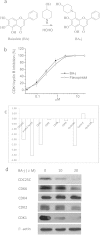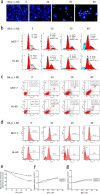BA-j as a novel CDK1 inhibitor selectively induces apoptosis in cancer cells by regulating ROS
- PMID: 26330167
- PMCID: PMC4557050
- DOI: 10.1038/srep13626
BA-j as a novel CDK1 inhibitor selectively induces apoptosis in cancer cells by regulating ROS
Abstract
Cyclin-dependent kinase 1 (CDK1) is the only necessary CDK in cell proliferation and a novel target in the development of anticancer drugs. 8-Hydroxypiperidinemethyl-baicalein (BA-j) is a novel selective CDK1 inhibitor with broad spectrum anti-cancer activity (IC50 12.3 μM) and 2 tumor xenografts. Because of the differential mechanisms controlling redox-states in normal and cancer cells, BA-j can capture oxygen free radicals ((·)O2(-)) and selectively increase the level of H2O2 in cancer cells, thereby specifically oxidize and activate the intrinsic apoptosis pathway bypassing the extrinsic death receptor pathway, thus inducing apoptosis in cancer cells rather than in normal cells. BA-j is different from cytotoxic anticancer drugs which can activate both the intrinsic apoptosis pathway and the extrinsic death receptor pathway, and therefore harm normal cells while killing cancer cells. The molecular and biochemical mechanisms of reactive oxygen species (ROS) regulation suggest that BA-j may be developed into a novel anticancer agent.
Figures







Similar articles
-
Metabolism and pharmacokinetics of 8-hydroxypiperidinylmethyl-baicalein (BA-j) as a novel selective CDK1 inhibitor in monkey.Fitoterapia. 2015 Dec;107:36-43. doi: 10.1016/j.fitote.2015.10.001. Epub 2015 Oct 22. Fitoterapia. 2015. PMID: 26474673
-
Synthesis and Biological Evaluation of Scutellaria Flavone Cyclaneaminol Mannich Base Derivatives as Novel CDK1 Inhibitors.Anticancer Agents Med Chem. 2016;16(7):914-24. doi: 10.2174/1871520615666150928114425. Anticancer Agents Med Chem. 2016. PMID: 26411959
-
Effective Killing of Cancer Cells Through ROS-Mediated Mechanisms by AMRI-59 Targeting Peroxiredoxin I.Antioxid Redox Signal. 2016 Mar 10;24(8):453-69. doi: 10.1089/ars.2014.6187. Epub 2015 Dec 18. Antioxid Redox Signal. 2016. PMID: 26528922
-
Discovery and evaluation of dual CDK1 and CDK2 inhibitors.Cancer Res. 2006 Apr 15;66(8):4299-308. doi: 10.1158/0008-5472.CAN-05-2507. Cancer Res. 2006. PMID: 16618755
-
Reactive Oxygen Species (ROS): Key Components in Cancer Therapies.Anticancer Agents Med Chem. 2022;22(2):215-222. doi: 10.2174/1871520621666210608095512. Anticancer Agents Med Chem. 2022. PMID: 34102991 Review.
Cited by
-
Emodin Induces Apoptosis of Colon Cancer Cells via Induction of Autophagy in a ROS-Dependent Manner.Oncol Res. 2018 Jul 5;26(6):889-899. doi: 10.3727/096504017X15009419625178. Epub 2017 Jul 25. Oncol Res. 2018. PMID: 28762328 Free PMC article.
-
Borcalein: a Carborane-Based Analogue of Baicalein with 12-Lipoxygenase-Independent Toxicity.ChemMedChem. 2022 Jan 5;17(1):e202100588. doi: 10.1002/cmdc.202100588. Epub 2021 Nov 11. ChemMedChem. 2022. PMID: 34694057 Free PMC article.
-
Baicalein sensitizes triple negative breast cancer MDA-MB-231 cells to doxorubicin via autophagy-mediated down-regulation of CDK1.Mol Cell Biochem. 2023 Jul;478(7):1519-1531. doi: 10.1007/s11010-022-04597-9. Epub 2022 Nov 21. Mol Cell Biochem. 2023. PMID: 36413334
-
HSP60 critically regulates endogenous IL-1β production in activated microglia by stimulating NLRP3 inflammasome pathway.J Neuroinflammation. 2018 Jun 9;15(1):177. doi: 10.1186/s12974-018-1214-5. J Neuroinflammation. 2018. PMID: 29885667 Free PMC article.
-
Identification of Key Genes and Pathways in Cervical Cancer by Bioinformatics Analysis.Int J Med Sci. 2019 Jun 2;16(6):800-812. doi: 10.7150/ijms.34172. eCollection 2019. Int J Med Sci. 2019. PMID: 31337953 Free PMC article.
References
-
- Santamaria D. et al. Cdk1 is sufficient to drive the mammalian cell cycle. Nature 448, 811–815 (2007). - PubMed
-
- Malumbres M. & Barbacid M. Cell cycle, CDKs and cancer: a changing paradigm. Nat Rev Cancer 9, 153–166 (2009). - PubMed
-
- Diaz-Padilla I., Siu L. L. & Duran I. Cyclin-dependent kinase inhibitors as potential targeted anticancer agents. Invest New Drug 27, 586–594 (2009). - PubMed
-
- Rizzolio F., Tuccinardi T., Caligiuri I., Lucchetti C. & Giordano A. CDK inhibitors: from the bench to clinical trials. Curr Drug Targets 11, 279–290 (2010). - PubMed
-
- Wesierska-Gadek J., Maurer M., Zulehner N. & Komina O. Whether to target single or multiple CDKs for therapy? That is the question. J Cell Physiol 226, 341–349 (2011). - PubMed
Publication types
MeSH terms
Substances
LinkOut - more resources
Full Text Sources
Other Literature Sources
Miscellaneous

